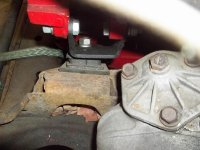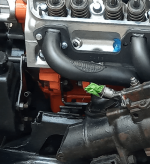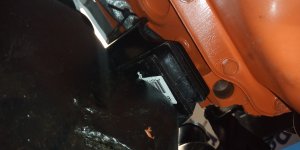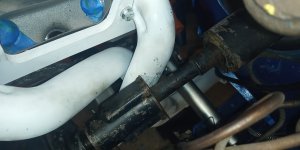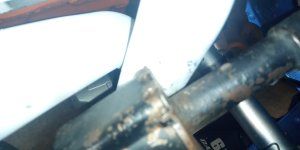K-member is about what I'd expect to see, so no more investigation there. I'd sorta suspected you had a Slant Six K, which isn't as different as you might think (and is why the adapter kits use the '72-up truck mount--to make up additional distance between the K and engine). As you mentioned, the K-member bolts are piloted, so it almost has to be located correctly to the frame rails if it's 100% secured. Besides, all your clearance issues are with things located by the K itself, not the body to which it's bolted. Move the K, you move the torsion bars, steering box/linkage, half the steering column, etc.
Looking at the photo on their website, it looks like your engine needs to go down and to the right (toward the passenger's side). It's hard to say, though, because the angle isn't quite the same. Their #7 primary appears to be lower in relation to the steering column, and while there's not a mile at the coupler it certainly looks to clear.
I seem to recall, and I could probably verify this with Stretch-a-Sketch, that when we were installing my headers we had to lift the engine on the passenger's side. I think it was while attempting the Thorley headers with the W2 adapters. With him pulling on the hoist/lifting chain toward the right, I had to give the valve cover several mighty heaves to get the engine to actually sit down all the way on the driver's side. Same issue--no matter where we tried to set it down, it ended up in the same spot. Remember, that slot in the K is 3 times longer than the diameter of the insulator stud. It wasn't easy, but it did eventually shift significantly and land where we needed it. Neither the steering column nor the header was in place yet, but weren't getting around the box when trying to install the header. We were also doing this with the car on the ground; in other words don't try such silly shit with it on jackstands. With the amount of push we needed to make it happen, it would have fallen off stands, no question.
Now, you'll forgive me making assumptions, but I'm going to guess B-Body-Babe is of smaller stature than myself, much less Jay-normous. Something that might help in this case would be to lift the driver's side enough to apply some kind of lubricant between the K-member and the insulator on the driver's side. Take both insulator-to-K nuts off completely. Set it back down, then lift the other side of the engine. Have Mrs. Bob (or a friend/neighbor/gullible passerby/your cabana boy) hold as much tension as possible on the chain toward the passenger's side while you push on that engine like it's a Kirby salesman that won't leave. Heave, release, heave again. I had to do it a few times, but it finally did move despite looking like it wouldn't. Stretch and I are both bigger guys (though I'm far from Mr. Atlas, 6" of extra height = leverage) so that's why I think putting grease, Vaseline, even maybe dish soap between the insulator and K might be a boon in your case. If you've got some way of prying on the engine in relation to the K, even better. Whomever helps needs to be ready to release the hoist as soon as you tell them (ASAP after it shifts). Oh, yeah--snug up the bracket-to-block fasteners so the assemblies can't cock and prevent movement. If possible, hold them up while you do so to give yourself maximum stud spacing at the K side of the insulator.
If that stud moves down only 1/8" in the K-member slot, it'll make a world of difference. Even if you still have to ding the headers for the coupler, it'll be dramatically less. I know you think it can't move, but I've got one American dollar that says it will. It just takes some serious effort to do it.
This is all I've got left to suggest. In my eyes, it really can't be anything else, unless your K is wrong (it isn't), the brackets/insulators are wrong or mis-installed (they don't appear to be, after going out and looking at a stock '68 340 K with the mounts and brackets still on it), or the car's been hit so colossally hard that both the frame rails and K-member are severely bent (it hasn't). Agnes had taken a hard hit at some point in the right front--the rail is still wrinkled--and it still went together. The only other possibility is that Doug's somehow completely blew the manufacture of a CNC-bent header (or two), or shipped you wrong parts. The former is possible but unlikely, and the latter is easily verified since the part number should be stamped in the header flange.
Note: 1/2" adapters be damned, we did get that Thorley header into place after the engine shifted. There was significant mangling of the primary, but that's to be expected with that much extra material added to the cylinder head.





